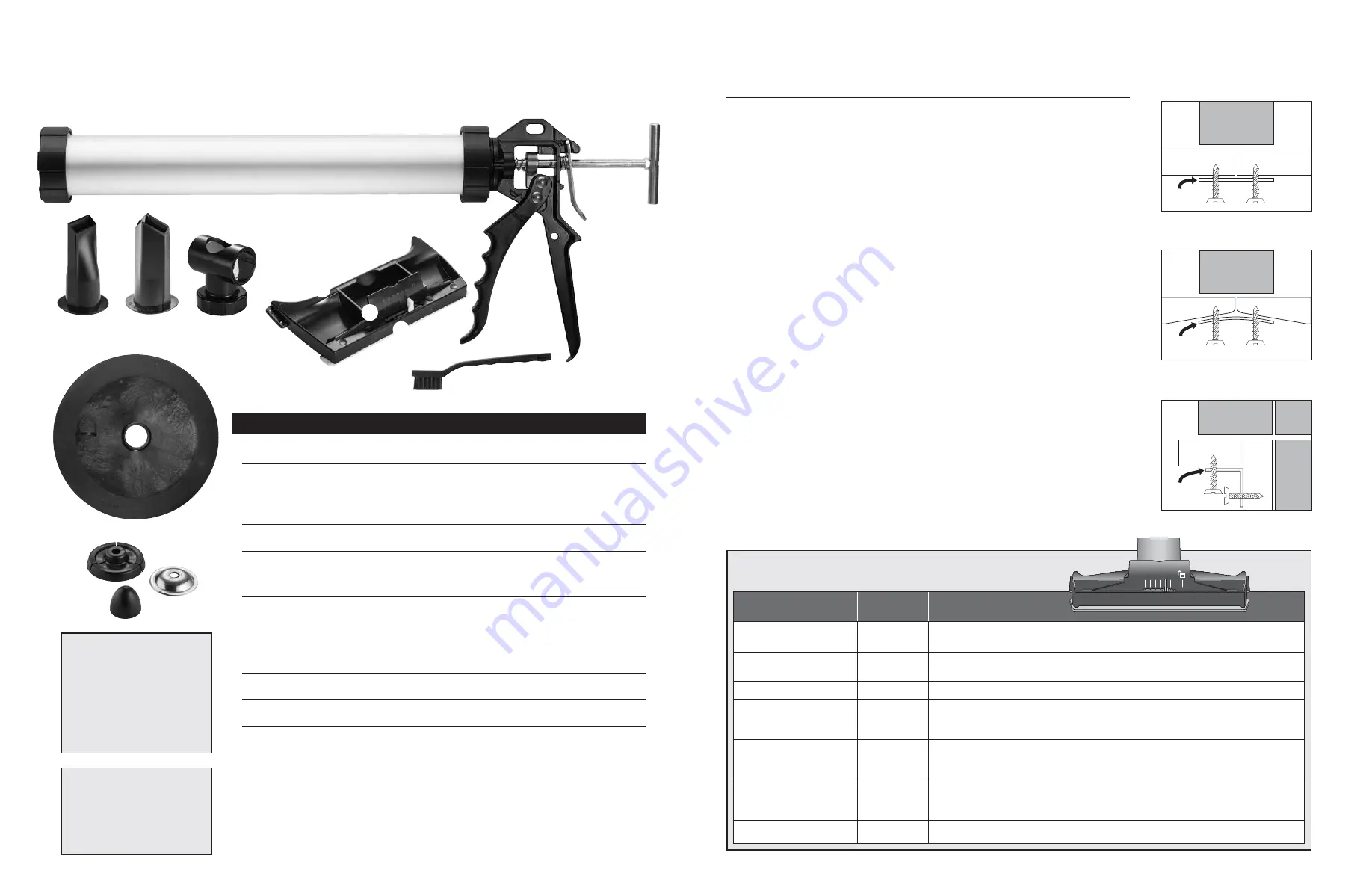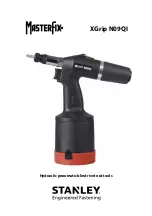
System Contents
A
MudGun
™
Trigger
Mud tube
Mud tube front ring
Brake
Plunger rod
Mud tube back ring
B
Loading ring
Embedding tools
C
Flat joint nozzle
D
Inside corner nozzle
Finishing tools
E
T-adapter
F
7-inch
finishing
head
Front
Adjustable crown/contour
Slide adjuster
Skid pads
G
Tool cleaning brush
H
MudPak
™
adapter
You will also need:
• Drywall compound
• 4-6 inch flexible taping knife
(5-gallon bucket)
• Inside corner smoothing tool
• Utility knife
• Two 5-gallon buckets filled with
• Joint tape
4 inches of water
(paper or adhesive mesh)
• Pole sander with 150- and 220-grit
• Electric drill with a mixing
sandpaper
attachment
• 220-grit sandpaper or sanding sponge
• Damp rags
MUDGUN
™
PRo (model #09610)
A
B
H
G
C
F
D
E
TIP
One bucket is for resting your
MudGun
™
to keep it clean and
free flowing for the duration of
the job. The other bucket is for
washing your hands and tools
and keeping rags damp.
TIP
There are many types of
drywall tape.
We recommend
using mesh or pre-scored
paper tape with this tool.
14
TAPING/FINIShING FULL RooMS
Taping a full room is best completed with a
MudGun
™
PRO
, which allows you
to bulk-load drywall compound directly from a 5-gallon bucket. You can also
adapt your
MudGun
™
Small Repairs
model for bulk-loading using a conversion
kit (HYDE
®
item #09630), available at the store where you purchased your
MudGun
™
or online at hydestore.com.
GETTING STARTEd
There are three types of joints to be taped: butt, tapered (manufactured) and
corner joints.
It’s best to tape your joints in the following order:
Butt joints are those that have the cut edges of two sheets of drywall meeting
each other. (A tapered edge meeting a cut edge is unacceptable, as it is not
possible to finish it properly.) When finished, a butt joint will not be flat. A slight
crown (outward bump) will result as you apply the tape and coats of mud over
an already flat surface.
Tape these joints first.
Tapered joints are those that have one wrapped, tapered edge of the drywall
meeting another tapered edge of drywall and are easiest to finish because
they will be flat after you fill the taper in the drywall (see illustration). Normally
on walls, tapered joints run horizontally because you can buy drywall sheets
in different lengths and create one long tapered joint with few or no butt joints
bisecting it vertically.
Tape these joints after the butt joints.
Corner joints are those that form a corner, such as where two walls meet or the
wall meets the ceiling. Like butt joints, corner joints won’t be flat or truly squared
when finished, since you’ll be adding tape and mud to surfaces that are already
flat. The goal with corner and butt joints is to cover the joint with a minimum
crown effect.
Tape your corners last.
sTud
bUTT jOinT
TApeR jOinT
CORneR jOinT
sTud
sTud
sT
ud
sT
ud
dryWall
dryWall
Tape
dryWall
Tape
dryWall
Tape
dryWall
dryWall
dryWall
dryWall
dr
yW
all
15
TIP
For best results, use this guide when using the MudGun
™
Finishing Head.
Finishing Head Settings
Crown
On Slide Adjuster
Thickness
Recommended Uses
0
flat
•
Center pass on Butt Joints after feathering sides.
•
Taper Joints if 2nd pass is needed due to mud having cracks.
1
1/64"
•
Feather Butt Joints, but 2 is recommended in case sanding needed.
•
Finish Taper Joints if doing feathering on sides.
2
2/64"
•
Finish Taper Joints with one pass (mud may crack due to thickness.)
3 3/64”
•
First coat bead, centered over slightly uneven joints.
•
Slightly uneven wall repairs where filling is needed.
Note: May have cracking that needs to be filled with another coat set on 0.
4
4/64"
•
First coat bead, centered over moderately uneven joints.
•
Moderately uneven wall repairs where filling is needed.
Note: May have cracking that needs to be filled with another coat set on 0.
5
5/64"
•
First coat bead, centered over heavily uneven joints.
•
Heavily uneven wall repairs where filling is needed.
Note: May have cracking that needs to be filled with another coat set on 0.
Unlock
•
Releases Slide adjuster and Adjustable Crown/Contour for cleaning
5 4 3 2 1 0































